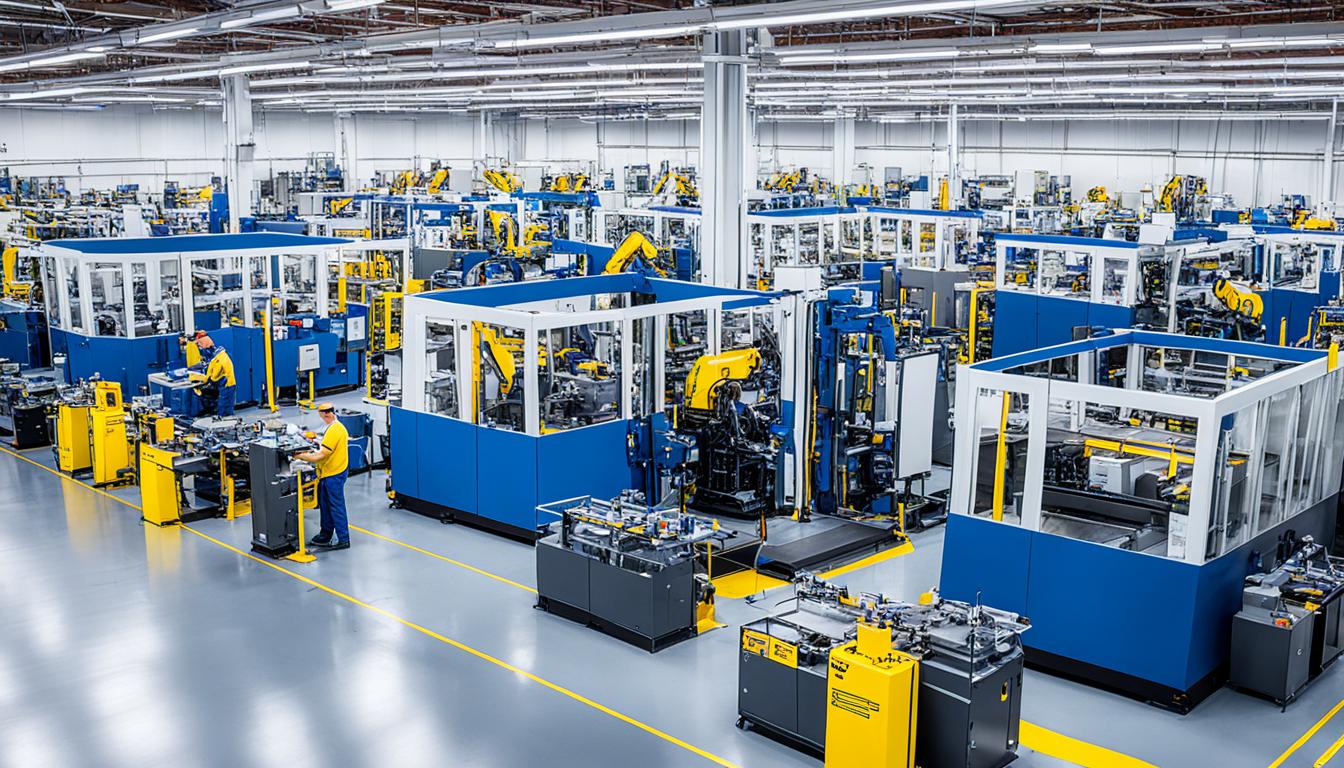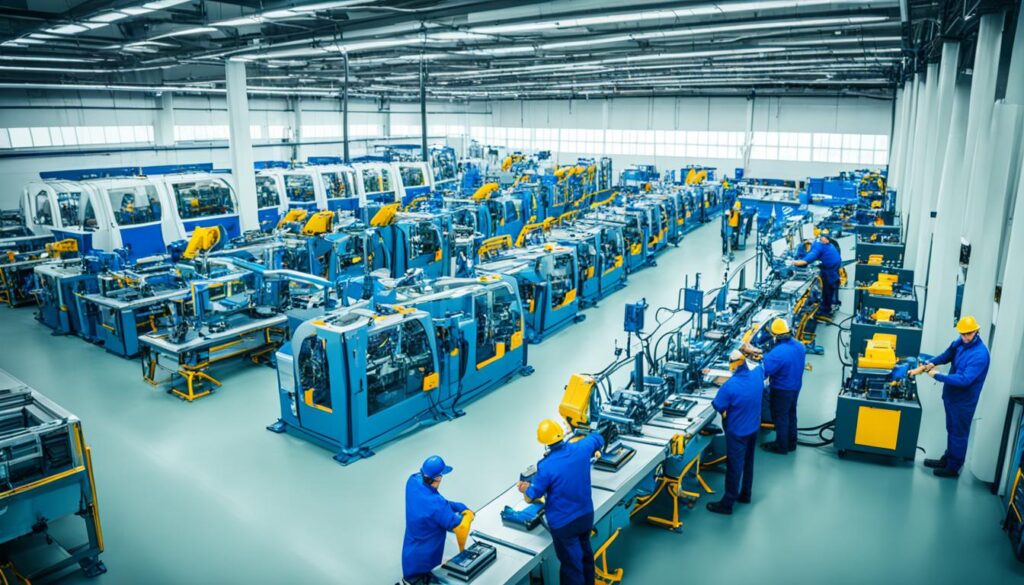Boost Your Factory’s Output: Productivity Improvement in Manufacturing Industry

Are you struggling to maximize your factory’s output and achieve operational efficiency in the manufacturing industry? Do you want to uncover the secrets to increasing productivity and optimizing your manufacturing processes?
In today’s competitive market, improving productivity is essential for the success of your manufacturing operations. From efficient production processes to implementing lean manufacturing strategies, there are proven techniques that can significantly boost your factory’s output and profitability.
In this article, we will explore practical tips and productivity optimization techniques that can help you improve productivity in your manufacturing operations. Get ready to unlock the potential of your factory and elevate your business performance to new heights.
Key Takeaways:
- Implement efficient production processes to enhance productivity.
- Adopt lean manufacturing strategies to optimize resource usage.
- Invest in modern machinery to improve production efficiency.
- Train your employees to perform tasks efficiently and stay updated with the latest manufacturing techniques.
- Utilize data for decision-making to identify bottlenecks and drive continuous improvement.
The Benefits of Productivity Improvement in Manufacturing
Improving productivity in the manufacturing industry offers numerous benefits. Firstly, it enhances manufacturing productivity, leading to cost efficiency and lower production costs. By making the most of your resources and streamlining production processes, you can produce more goods without increasing costs.
Additionally, increased productivity allows for higher output, resulting in greater sales and profit margins. It also gives your company a competitive advantage, enabling you to deliver goods faster, offer lower prices, and provide higher quality products, ultimately leading to increased market share.

Strategies for Productivity Improvement in Manufacturing
Improving productivity in the manufacturing industry requires the implementation of various strategies. By adopting lean manufacturing techniques, investing in modern machinery, training employees, utilizing data for decision-making, and maintaining equipment, you can optimize your factory’s productivity and drive business success.
1. Implement Lean Manufacturing
Lean manufacturing is a proven approach to eliminate waste, improve workflow, and optimize resource usage. By implementing lean principles such as Just-In-Time production, Kanban systems, and continuous improvement processes, you can streamline operations and enhance productivity.
2. Invest in Modern Machinery
Upgrading your machinery to modern equipment with advanced features can have a significant impact on productivity. Look for machines with automation capabilities, energy efficiency, and improved speed and accuracy. By leveraging cutting-edge technology, you can effectively increase output while reducing downtime.
3. Train Your Employees
Your employees play a crucial role in improving productivity. Provide them with comprehensive training to ensure they have the necessary skills and knowledge to perform their tasks efficiently. Regularly update their training to keep pace with the latest manufacturing techniques and technologies, empowering them to contribute to productivity optimization.
4. Use Data for Decision-Making
Data-driven decision-making is a powerful tool to identify bottlenecks and streamline processes. Implement systems to collect and analyze data related to production metrics, quality control, and resource utilization. Leverage this data to gain insights into areas for improvement and make informed decisions that positively impact productivity.
5. Maintain Your Equipment
Regular equipment maintenance is essential to prevent breakdowns and optimize performance. Implement preventive maintenance schedules to ensure that machines operate at peak efficiency. By addressing potential issues before they escalate, you can minimize downtime and maximize productivity.
By implementing these strategies in your manufacturing operations, you can achieve significant improvements in productivity, efficiency, and overall business performance. Remember, productivity improvement is an ongoing process, so regularly assess and refine your strategies to stay ahead in the competitive manufacturing industry.
| Strategies | Description |
|---|---|
| Implement Lean Manufacturing | Adopt lean principles to eliminate waste, improve workflow, and optimize resources. |
| Invest in Modern Machinery | Upgrade to advanced equipment with automation capabilities and energy efficiency. |
| Train Your Employees | Provide comprehensive training to ensure employees have the necessary skills and knowledge. |
| Use Data for Decision-Making | Utilize data to identify bottlenecks, make informed decisions, and drive productivity. |
| Maintain Your Equipment | Implement preventive maintenance to optimize equipment performance and minimize downtime. |

Factors to Consider for Manufacturing Productivity Improvement
When aiming to improve productivity in the manufacturing industry, it is important to consider several factors. By optimizing the factory layout, implementing quality control measures, encouraging employee engagement, fostering a culture of continuous improvement, and implementing a quality management system, you can drive significant productivity gains and enhance business performance.
Optimize Layout
One crucial factor in improving manufacturing productivity is optimizing the layout of your factory. By organizing work areas and materials flow in a logical and efficient manner, you can enhance workflow efficiency, minimize time wasted on unnecessary movement, and improve overall productivity. A well-designed layout streamlines production processes and ensures smooth operations.
Implement Quality Control Measures
Ensuring consistent product quality is vital for manufacturing productivity improvement. Implementing robust quality control measures helps catch and correct errors before they become costly problems. By maintaining high product standards and minimizing defects, you can avoid rework, reduce waste, and improve customer satisfaction. Quality control measures also contribute to a more efficient production process.
Encourage Employee Engagement
Engaged employees are more productive and motivated to contribute their best efforts to the manufacturing process. Creating positive work environments, implementing recognition programs, and offering growth opportunities can significantly increase employee engagement. When employees feel valued and empowered, they are driven to perform at their highest level, leading to enhanced productivity and overall business success.
Foster a Culture of Continuous Improvement
A culture of continuous improvement is key to driving productivity gains in manufacturing. By encouraging employees to constantly seek ways to enhance work processes and identify areas for improvement, you foster a culture of innovation and efficiency. Regularly reviewing and refining manufacturing practices, seeking input from employees, and implementing their suggestions can result in incremental productivity gains and long-term success.
Implement a Quality Management System
A quality management system (QMS) provides a structured approach to managing product quality and standardizing production processes. By implementing a QMS, you establish clear procedures, guidelines, and documentation for all aspects of manufacturing. This helps reduce errors, ensure consistency, and improve overall efficiency, ultimately leading to increased productivity and optimized manufacturing operations.
By considering these key factors and implementing the necessary strategies, you can drive tangible productivity improvements in your manufacturing operations. Optimizing layout, implementing quality control measures, encouraging employee engagement, fostering a culture of continuous improvement, and implementing a quality management system are all vital steps towards achieving your productivity goals.
Conclusion
Boosting factory productivity in the manufacturing industry is a continuous journey towards excellence. By adopting a holistic approach and implementing strategies such as lean manufacturing, investing in modern machinery, and training your employees, you can optimize your operations and achieve higher levels of output. Utilizing data for decision-making and maintaining your equipment ensures efficiency and productivity optimization.
However, there are additional factors to consider in your quest for productivity improvement. Optimizing your factory layout, implementing quality control measures, and fostering a culture of continuous improvement are crucial. Encouraging employee engagement and implementing a quality management system further enhance productivity by creating an environment that encourages innovation and efficiency.
By continuously striving for productivity improvement, your factory can achieve optimal output, drive business success, and stay ahead in the competitive manufacturing landscape. Remember, productivity optimization is not a destination; it is a journey that requires constant evaluation, adaptation, and a commitment to continuous improvement. Embrace this mindset, and watch your factory thrive.
FAQ
What is the importance of productivity improvement in the manufacturing industry?
Productivity improvement in the manufacturing industry is crucial for boosting your factory’s output and profitability. It allows you to produce more goods without increasing costs, leading to cost efficiency and lower production costs. Increased productivity also results in higher output, greater sales, and profit margins, giving your company a competitive advantage and increased market share.
What strategies can be implemented to improve productivity in manufacturing?
One effective strategy is adopting lean manufacturing techniques, which involve eliminating waste, improving workflow, and optimizing resource usage. Investing in modern machinery with advanced features and training employees to perform tasks efficiently are also crucial. Using data for decision-making, identifying bottlenecks, and implementing maintenance schedules to optimize equipment performance are additional strategies for productivity improvement in manufacturing.
What factors should be considered for manufacturing productivity improvement?
Optimizing the factory layout, implementing quality control measures, encouraging employee engagement, fostering a culture of continuous improvement, and implementing a quality management system are important factors to consider. These actions improve workflow efficiency, ensure consistent product quality, increase employee productivity, and standardize production processes.






